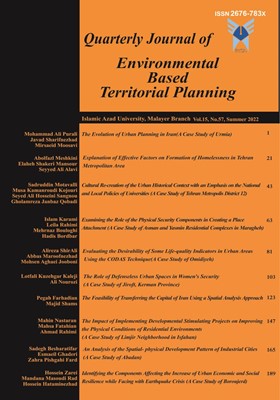Cultural Re-creation of the Urban Historical Context with an Emphasis on the National and Local Policies of Universities (A Case Study of Tehran Metropolis District 12)
Subject Areas :Sadraddin Motavalli 1 , Mousa Kamanroudi 2 , Seiied Ali Hosseini Sangno 3 , Gholamreza Janbaz Qobadi 4
1 - Department of Geography, Noor Branch, Islamic Azad University, Mazandaran, Iran
2 - Department of Human Geography, Kharazmi University, Tehran, Iran
3 - Department of Geography, Noor Branch, Islamic Azad University, Mazandaran, Iran
4 - Department of Geography, Noor Branch, Islamic Azad University, Mazandaran, Iran
Keywords: Universities, urban regeneration, Historical context, cultural regeneration, District 12 of Tehran ,
Abstract :
In recent years, the connection between the university and the city has increasingly become a pervasive issue. Among the effective domains of the university is its role in improving the cultural quality of the historical context of cities. For this purpose, in this research, the role of the university in the cultural re-creation of the historical fabric of the Tehran metropolis has been investigated. The purpose of this research is to identify the performance criteria of universities in the cultural reproduction of the historical context. The research method is applied and descriptive-analytical. The research scope of the historical fabric of Tehran corresponds to the 12th district of Tehran Municipality. The statistical population of the research is specialists and faculty of urban planning, urban planning, and architecture. The sample of the study included 35 people and this number was chosen based on the opinion saturation of the elites. The method of data collection was an observation, semi-structured interview, and questionnaire. The method of data analysis was using the T-Test and structural equation method. The findings showed that universities can play an effective role in cultural regeneration with various examples. In this regard, the coefficient of the path between the performance variable of universities in cultural regeneration is 0.971, which indicates the fact that the mechanisms governing the internal structure of universities in the cultural field can be implemented as manifestations of cultural regeneration in the old context. Also, the structure of the effect of national and local policies on the performance of universities shows that these policies, especially in the national field, with a coefficient of 0.978 have a positive effect on the performance of universities. Therefore, it can be concluded that national policies have influenced the performance of universities and this performance can show its manifestations in cultural regeneration.
Vicjery, J. 2007. The Emergence of Culture-led Regeneration: A policy concept and its discontents. University of Warwick: Centre for Cultural Policy StudiesWiewel, W., & Perry, D. 2005. Global universities and urban development: case studies and analysis. Edition 1. Published by Routledge. 360 pages.
_||_

